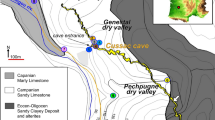Abstract
Show caves are great natural attractions and constitute important economic engines for particular rural areas. However, cave management requires knowledge of the cave dynamics to ensure adequate exploitation and conservation (e.g. number of visitors, amount of CO2, other impacts). Show caves located close to the hydrological base level can be affected by a sudden rise of the water level in response to rainfall events, exposing touristic facilities, visitors and staff to flood risk. Here we present a monitoring campaign in Las Güixas show cave, a small tourist cave located in the Central Pyrenees, to guide in developing an adequate flood risk management plan (FRMP). Cave monitoring includes temperature, relative humidity, CO2 concentration and water level measurements to characterize the different cave sections, as well as to assess the possible influence of the visitors on the cave dynamics. The tourist section is very well ventilated due to intense air flow associated with a chimney effect, and therefore CO2 remains low and temperature shows high thermal oscillations throughout the year. During the maximum number of visits per day, the CO2 generated by the tourists increases, however, is quickly reduced by the ventilation. Water level monitoring shows clear rises depending on the amount of rainfall and snowmelt in the catchment area. However, the water level does not always respond to given rainfall amounts in the same way, indicating that the water retained in the karst system plays an important role. Water can flood the tourist section forcing to cancel the following visits which generates economic losses. In addition, the higher water flow increases the natural inputs of CO2 in the cave atmosphere due to degassing. Las Güixas cave monitoring shows that anthropogenic CO2 emissions remain substantially lower than CO2 concentrations during the flood events.
Access this chapter
Tax calculation will be finalised at checkout
Purchases are for personal use only
Similar content being viewed by others
References
Bengoetxea A, García D, García JM, Yzaguirre I (1994) Exploraciones del G.E.R.S en el Macizo de la Collarada (Huesca). Subterránea 2:8–14
Bourges F, Genty D, Perrier F et al (2020) Hydrogeological control on carbon dioxide input into the atmosphere of the Chauvet-Pont d’Arc cave. Sci Total Environ 716:136844. https://doi.org/10.1016/j.scitotenv.2020.136844
Lambert WJ, Aharon P (2011) Controls on dissolved inorganic carbon and δ13C in cave waters from DeSoto Caverns: Implications for speleothem δ13C assessments. Geochim Cosmochim Acta 75:753–768. https://doi.org/10.1016/j.gca.2010.11.006
Lang M, Faimon J, Ek C (2015) The relationship between carbon dioxide concentration and visitor numbers in the homothermic zone of the Balcarka Cave (Moravian Karst) during a period of limited ventilation. International Journal of Speleology 44:https://doi.org/10.5038/1827-806X.44.2.6
Le Quéré C, Jackson RB, Jones MW et al (2020) Temporary reduction in daily global CO2 emissions during the COVID-19 forced confinement. Nat Clim Chang 10:647–653. https://doi.org/10.1038/s41558-020-0797-x
Rivas A, Cabezas J, Carrasco F, et al. (2004) Las cuevas turísticas españolas: Un recurso natural de gran interés ecológico, económico y social. In: Andreo B, Durán JJ (eds) Investigaciones en sistemas kársticos españoles. Publicaciones del Instituto Geológico y Minero de España. Serie Hidrogeología y Aguas Subterráneas 12:367–384
Smerdon JE, Pollack HN, Cermak V, et al (2004) Air-ground temperature coupling and subsurface propagation of annual temperature signals. J Geophys Res Atmospheres 109. https://doi.org/10.1029/2004JD005056
Author information
Authors and Affiliations
Corresponding author
Editor information
Editors and Affiliations
Rights and permissions
Copyright information
© 2023 The Author(s), under exclusive license to Springer Nature Switzerland AG
About this paper
Cite this paper
Giménez, R., Bartolomé, M., Ezquerro, L., Benito, G., Luetscher, M., Moreno, A. (2023). Hydrological and Environmental Dynamics in Las Güixas Show Cave: Tourist Exploitation and Flood Risk Management. In: Andreo, B., Barberá, J.A., Durán-Valsero, J.J., Gil-Márquez, J.M., Mudarra, M. (eds) EuroKarst 2022, Málaga. Advances in Karst Science. Springer, Cham. https://doi.org/10.1007/978-3-031-16879-6_24
Download citation
DOI: https://doi.org/10.1007/978-3-031-16879-6_24
Published:
Publisher Name: Springer, Cham
Print ISBN: 978-3-031-16878-9
Online ISBN: 978-3-031-16879-6
eBook Packages: Earth and Environmental ScienceEarth and Environmental Science (R0)




